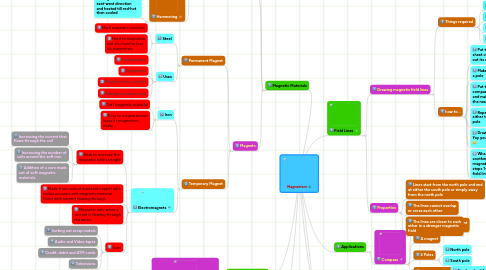
1. Law of Magnetism
1.1. Like Poles Repel, Unlike Poles Attract
2. Properties
2.1. Found in magnetic materials
2.1.1. Metals
2.2. Not found in non-magnetic materials
2.2.1. Plastics
2.2.2. Fabrics
2.2.3. Wood
3. Induced magnetism
3.1. eg. a single bar magnet can attract a iron nail hence becoming a magnet. In turn attracting another nail. When the bar magnet is removed,Both the nails fall off due to the lost of their induced magnetism.
4. Magnetic Materials
4.1. May Undergo Magnetisaton
4.1.1. Stroking
4.1.1.1. Take one permenant magnet and stroke a magnetic material lenghtwise. Stroke from end to end over 20 continuous strokes
4.1.1.1.1. End of the magnetised bar where the strokes end has the opposite polarity of the end of which the stroking magnets is in contact with
4.1.2. Using Direct Current
4.1.2.1. A steel bar is inserted into a solenoid and a direct current is made to flow through the solenoid. A strong magnetic current is produced by the solenoid leading to the steel bar becoming magnetised.
4.1.2.1.1. When the current is switched off, the steel bar remains magnetised
4.2. May Undergo Demagnetisation
4.2.1. Heating
4.2.1.1. magnet must lie in an east-west direction
4.2.2. Hammering
4.2.2.1. magnet must lie in an east-west direction and heated till red-hot then cooled
4.3. Magnets
4.3.1. Permanent Magnet
4.3.1.1. Steel
4.3.1.1.1. Hard magnetic material.
4.3.1.1.2. Hard to magnetise but also hard to lose its magnetism
4.3.1.2. Uses
4.3.1.2.1. Loudspeakers
4.3.1.2.2. Compasses
4.3.1.2.3. Magnetic door catches
4.3.1.2.4. Refrigerator door seals
4.3.2. Temporary Magnet
4.3.2.1. Iron
4.3.2.1.1. Soft magnetic material
4.3.2.1.2. Easy to magnetise but loses its magnetism easily
4.3.2.2. Electromagnets
4.3.2.2.1. How to increase the magnetic field strength
4.3.2.2.2. Made from coils of insulated copper wire coiled around a soft magnetic material (iron) with current flowing through
4.3.2.2.3. Magnetic only when a current is flowing through the wires.
4.3.2.2.4. Uses
5. Applications
5.1. Compass
5.1.1. Discovered by the ancient Chinese in 2000BC
5.1.2. A magnet
5.1.3. 2 Poles
5.1.3.1. North pole
5.1.3.2. South pole
5.1.4. Similar to a bar magnet
6. Bar magnet(1)
6.1. with...
6.1.1. Bar magnet (2)
6.1.1.1. North pole of 1 attracts south pole of 2
6.1.1.2. North pole of 1 repels north pole of 2
6.1.2. soft iron rod (magnetic material) (2)
6.1.2.1. North pole of 2 can be attracted by either poles of 1
6.1.3. a non-magnetic material (wood) (2)
6.1.3.1. 1 and 2 remain stationary
6.2. Strength
6.2.1. Peak strength is not at the poles but is around 0.5cm away from the poles.
7. Field Lines
7.1. Drawing magnetic field lines
7.1.1. Things required
7.1.1.1. Pencil
7.1.1.2. Paper
7.1.1.3. Compass
7.1.1.4. Bar magnet
7.1.2. how to...
7.1.2.1. Put the bar magnet on the sheet of paper, and trace out its shape
7.1.2.2. Make a dot at the edge of a pole
7.1.2.3. Put the end of the compass on top of the dot and make a dot at where the needle points.
7.1.2.4. Repeat Steps 1-3 till the dots reach either the end of the paper or the other pole
7.1.2.5. Draw a line to connect the dots. Yay you've got your first field line :)
7.1.2.6. When finished, pick another spot near the magnet and repeat steps 1-5 for more field lines
7.2. Properties
7.2.1. Lines start from the north pole and end at either the south pole or simply away from the north pole
7.2.2. The lines cannot overlap or cross each other
7.2.3. The lines are closer to each other in a stronger magnetic field
